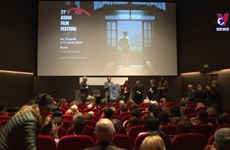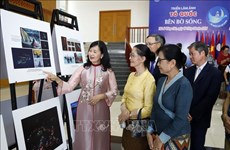Culture space of communal houses in delta on show
The art of architecture and sculpture, as well as local cultural
features from communal houses throughout the north of Vietnam, are being
displayed at an exhibition in Hanoi.
The art of architecture and sculpture, as well as local cultural
features from communal houses throughout the north of Vietnam, are being
displayed at an exhibition in Hanoi.
As many as 80 photos of communal houses, built between the 16th and 18th century, feature architectural designs, sculptures and local festivals. Also on display are 15 wooden and plaster copies of decorative sculptures from communal houses, as well as three documentaries on architecture and village festivals make up the exhibition, entitled Culture space of communal houses in Vietnam's northern Delta.
Visitors to the exhibition will also have the opportunity to participate in historic cultural activities at the communal houses through observing various objects displayed in the exhibition, such as worshipping the altar of the village's genie, and through folk songs and music by artists from the Vietnam Cheo (traditional opera) Theatre.
"During the development of modern society, communal houses, where villagers share cultural activities, are losing their roles in today's communities," said Le Van Suu, head master of Vietnam Fine Arts College, "The main reason for this problem lies in people's lack of awareness, understanding and respect toward the [communal houses] heritage."
"Such an exhibition is necessary to enhance people's awareness of the values and readiness to preserve both tangible and intangible cultural values at local communal houses."
The exhibition is a result of a two-year project carried out by a team of lecturers and students at the college in more than 10 northern and central provinces.
Nguyen Duc Binh, who had earlier participated in the project, told Viet Nam News that he and his friends had learnt much through their field trips.
"We felt regret as many communal houses were encroached upon by surrounding neighborhoods," he said, "The images of an old banyan tree, a well of fresh water and a large yard at the communal house no longer exist in many villages. At some communal houses, local communities have to build doors to close off communal houses to protect them from encroachment, which breaks up the original architecture of communal houses – as an open building for all people."
Bui Thi Thanh Mai, who was among the researchers for the project, expressed her sorrow at seeing many communal houses, which were completely new after expensive upgrades, while in contrast, many communal houses are being neglected and falling into disrepair.
Fine arts researcher Nguyen Hai Phong, from the Vietnam Fine Arts Institute, noted the exhibition's focus on architecture and sculpture in communal houses, through which all cultural lifestyles and esthetic conceptions of local residents can be understood.
"There is informality, even in the formal worship areas," he said, "For example, the scene of young men and women flirting with one another in the wooden sculptures. Or you can see a humorous scene of a tiger, who is always hunted by men in some sculptures, watching two men kicking a shuttle cork."
"It's good to organise such an exhibition for young urban people, especially foreign people like me," said Russian researcher Natasha Kraevskaia, who has lived in Vietnam for more than 20 years, "But I expect more objects from communal houses, like palanquins and statues, to be displayed here so those viewing can imagine life in communal houses in the countryside."
The exhibition is a part of a project entitled "Research, collect, advertise and bring into full play special values of communal houses culture heritage in Vietnam's northern Delta", which is being held by the Vietnam Fine Arts College between 2012 and 2013.
The exhibition runs until December 19. Also, a conference on issues of preservation and bringing into full play cultural values of communal houses will be held on December 10.-VNA
As many as 80 photos of communal houses, built between the 16th and 18th century, feature architectural designs, sculptures and local festivals. Also on display are 15 wooden and plaster copies of decorative sculptures from communal houses, as well as three documentaries on architecture and village festivals make up the exhibition, entitled Culture space of communal houses in Vietnam's northern Delta.
Visitors to the exhibition will also have the opportunity to participate in historic cultural activities at the communal houses through observing various objects displayed in the exhibition, such as worshipping the altar of the village's genie, and through folk songs and music by artists from the Vietnam Cheo (traditional opera) Theatre.
"During the development of modern society, communal houses, where villagers share cultural activities, are losing their roles in today's communities," said Le Van Suu, head master of Vietnam Fine Arts College, "The main reason for this problem lies in people's lack of awareness, understanding and respect toward the [communal houses] heritage."
"Such an exhibition is necessary to enhance people's awareness of the values and readiness to preserve both tangible and intangible cultural values at local communal houses."
The exhibition is a result of a two-year project carried out by a team of lecturers and students at the college in more than 10 northern and central provinces.
Nguyen Duc Binh, who had earlier participated in the project, told Viet Nam News that he and his friends had learnt much through their field trips.
"We felt regret as many communal houses were encroached upon by surrounding neighborhoods," he said, "The images of an old banyan tree, a well of fresh water and a large yard at the communal house no longer exist in many villages. At some communal houses, local communities have to build doors to close off communal houses to protect them from encroachment, which breaks up the original architecture of communal houses – as an open building for all people."
Bui Thi Thanh Mai, who was among the researchers for the project, expressed her sorrow at seeing many communal houses, which were completely new after expensive upgrades, while in contrast, many communal houses are being neglected and falling into disrepair.
Fine arts researcher Nguyen Hai Phong, from the Vietnam Fine Arts Institute, noted the exhibition's focus on architecture and sculpture in communal houses, through which all cultural lifestyles and esthetic conceptions of local residents can be understood.
"There is informality, even in the formal worship areas," he said, "For example, the scene of young men and women flirting with one another in the wooden sculptures. Or you can see a humorous scene of a tiger, who is always hunted by men in some sculptures, watching two men kicking a shuttle cork."
"It's good to organise such an exhibition for young urban people, especially foreign people like me," said Russian researcher Natasha Kraevskaia, who has lived in Vietnam for more than 20 years, "But I expect more objects from communal houses, like palanquins and statues, to be displayed here so those viewing can imagine life in communal houses in the countryside."
The exhibition is a part of a project entitled "Research, collect, advertise and bring into full play special values of communal houses culture heritage in Vietnam's northern Delta", which is being held by the Vietnam Fine Arts College between 2012 and 2013.
The exhibition runs until December 19. Also, a conference on issues of preservation and bringing into full play cultural values of communal houses will be held on December 10.-VNA












